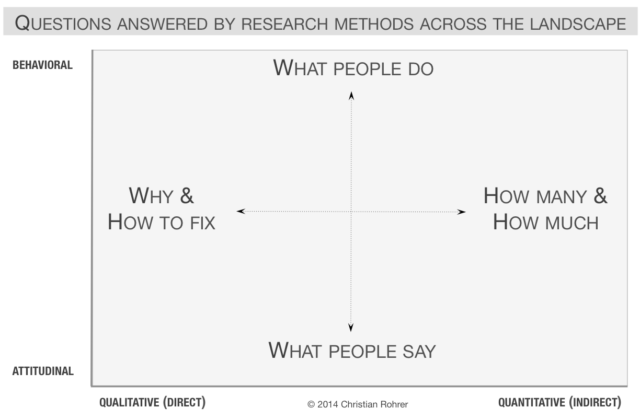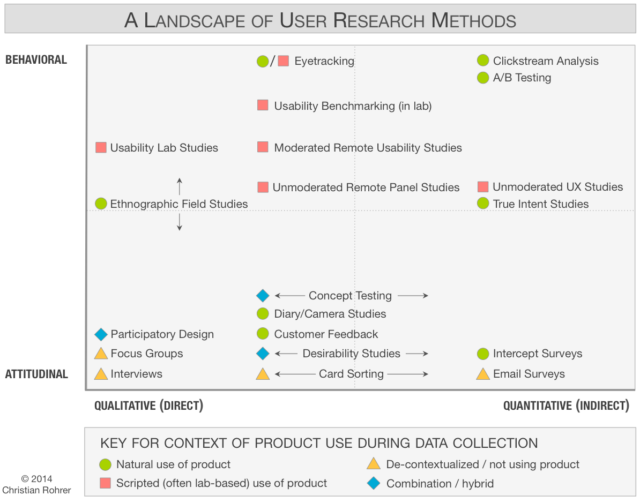User experience design isn’t effective without user research to back it up. The whole point of UX design is to serve your user base or target audience, and it helps to know what they need and want. As defined by the Interaction Design Foundation:
“UX (user experience) research is the systematic study of target users and their requirements, to add realistic contexts and insights to design processes.”
Simply put, user research allows you to optimize designs by solving and preventing problem areas and uncovering opportunities.
But there’s a lot of room for problems and opportunities – a lot of questions that need answering. In turn, there are a lot of user research methods to choose from, from usability testing to data mining, and you need the right one to find the right answers. So how do you choose?
Understanding the research process that goes into creating effective UX and UI design is an excellent place to start.
The User Research and Design Process
Research is paramount at the beginning of the design process when critical decisions are made, but you can and should use it to make the right choices throughout the entire process. Use it to define your user base and information architecture to the placement of a CTA button. Doing so will ensure that you’re heading in the right direction at each step. Plus (and this is a big one), an error is much easier and less expensive to fix in the design process than in development.
Before you jump into research, your team needs a defined approach to establishing what you need to know, getting clear answers, interpreting those results, and implementing insights.
You can get more specific to meet your needs, but there is a standard five-step process for conducting user research:
- Define Your Objective: Determine what you need to know
- Hypothesize: Determine what you think you know
- Choose a Method: Decide on a research method
- Conduct It: Follow through
- Synthesize It: Sift for the insight you need
To a large degree, what you need to know will depend on where you are in the design process, of which there are four major steps:
- The Discover Phase: You’re still figuring out what matters to your users
- The Explore Phase: You’re ensuring that you’re meeting all user needs
- The Testing Phase: You’re actively testing your design choices
- The Listening Phase: You’re listening for feedback and analyzing success

How to Choose the Right Research Method For Your Needs
In an ideal scenario, you would combine the insights you gain from multiple types of user research methods and testing rounds. But in the real world, it can be hard to implement a new method, and resources can be limited.
With good planning, you can sometimes knock multiple questions out with one, but only if answering each requires the same method. A survey can answer more than one question; a usability test can examine a few solutions.
There are also many types of questions, and answering them correctly requires using the right research method. From testing usability metrics to conducting interviews, each solves a unique problem.
Define the Problem
To choose the right UX research methods for your needs, you first need to define your need – the problem at hand. Ask yourself what you already know and what you want to know as a result.
You will determine the method you use by the type of answers you need, and the type of answer will depend on the problem. Are you solving a usability issue? Testing a design? Thinking about adding a new feature? Looking for an opportunity? Adapting to changes in consumer behavior due to COVID-19?
Again, where you are in the design process can help establish what you need and narrow down your options.
At the beginning of the process, discovering user needs and motivations tend to take priority. Towards the final stages, the focus will be on ensuring that groups of users can navigate your design with ease. Good UX design will always account for accessibility.
Define the Type of Data You Need
With what you need to know in mind, you can more easily determine what kind of data will give you the answer. You can define UX research methods by two dimensions, each split into two approaches (for a total of four). Understanding the data each of these approaches provide will guide you in picking the right one to meet your needs.
Dimension 1: Qualitative vs. Quantitative
Qualitative Approach
Researchers use qualitative research to develop an in-depth understanding of users. It answers “why” questions: Why do they behave the way they do? It’s often done by obtaining verbal or written responses to open-ended questions so you can learn about their experience in their words.
A qualitative researcher may conduct:
- Ethnographic studies
- Focus groups
- Interviews
- Usability testing
- Contextual inquiries
- Diary studies
- Participatory design sessions
- Open-ended surveys or questionnaires
The trouble with qualitative research is that it can get skewed by poor questioning, communication misunderstandings, bias from either party, or lying to protect one’s image.
Quantitative Approach
Quantitative studies are measurable and unbiased. They function to answer “what” questions: What behaviors do users exhibit?
A quantitative researcher may conduct:
- Surveys
- Analytics
- A/B testing
- Benchmarking
- Tree testing
- Card sorting
- Eyetracking
- Desirability studies
Quantitative data is excellent for spotting areas for improvement, but it doesn’t provide the deep insight that qualitative data does.
Dimension 2: Attitudinal vs. Behavioral
Attitudinal Approach
An attitudinal approach to research is an approach that focuses on listening to users. It fills in the emotional aspect of the user experience by uncovering the thoughts, feelings, and opinions of your user base.
Behavioral Approach
A behavioral approach to research is about observing user behavior in action. This is important because users may act differently than they would imply in an attitudinal setting, like an interview.
Choosing Your Approach
You can see the two dimensions of qualitative vs. quantitative and attitudinal vs. behavioral depicted in the following chart.

As you can see, four quadrants make up the combination of research approaches. To choose the ideal combination of approaches, think about the answers you need and the best way to acquire them. Do you need to know what they do or why they do it? Should you listen to or observe your users?
Once you know which quadrant you’re operating under, you can continue to narrow down your user research methods of choice by thinking about the product’s context in answering your question.
You can define the product’s involvement as:
- Natural: To test the product in its natural state to understand user interaction as realistically as possible.
- Scripted: To test a specific usage area or redesign of the product.
- Decontextualized: The product isn’t involved in the study.
- Hybrid: A combination of the above.
The image below shows how UX research methods may align with qualitative, quantitative, attitudinal, and behavioral approaches based on product context.

Putting It All Together to Pick a Method
The UX research method you choose to conduct will depend on the stage of the design process you’re in and what you want to know. Always conduct research first to understand how your product will meet your audience’s needs. You can’t test your product’s effectiveness until you understand what being effective entails.
While behavioral and attitudinal research both have value, it’s often better to observe users’ behavior to discover their needs than to ask right out. Users can’t always provide the best answer since they aren’t UX design experts and may not know what they’re missing. For example, new inventions come out all the time that we didn’t know we needed.
You’ll also need to decide if what people think and believe or what they do with the product is more relevant to your question. The same goes for whether it’s more valuable to have numerical data on how users behave or verbal data on why they behave that way.
Often, though not a rule, qualitative research determines thoughts and motivations while quantitative research assesses success.
Once you’ve determined whether your research is quantitative, qualitative, attitudinal, or behavioral leaning, narrow your focus by assessing the product’s context in your question. If the question is more about the user or company, you may not need to involve the product. If it’s to test the product or a design iteration, use a natural or scripted method.
If you need more information on all the types of user research methods available and how to conduct them, refer to our complete guide on UX research methods.
Other Considerations
We’d love to send you off, claiming you’ve got the perfect process and that’s all you need, but we live in the real world. In the real world, other factors come into play when determining the research method you choose.
Big players that come to the table are cost, time, and resources. Research costs money and takes time. Sometimes you need answers sooner rather than later. Sometimes a method, like a survey, requires a certain number of participants to present reliable results.
UX researchers also need to stay in contact with business stakeholders. Stakeholders help ensure that research stays in line with business goals.
And of course, there’s the fact that even the perfect research method for a problem will only get you so far because research is a skilled profession in itself. The right researcher will make or break a study.
Start Creating Evidence-Driven Design
Good UX design is founded on good UX research. Without user research, who does the design serve? Not the people who matter: the people who use your product and the ones who will convert.
Start creating evidence-driven design by implementing research into your design process. Continually evaluate your research procedures and improve where you can to get clearer, accurate results and effective design.
Have questions or need help with the design or development process? Don’t hesitate to reach out.


